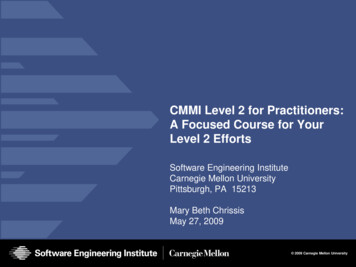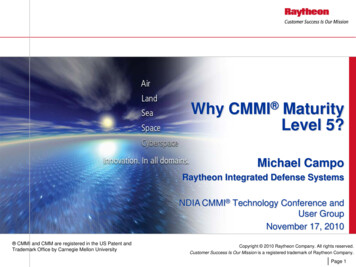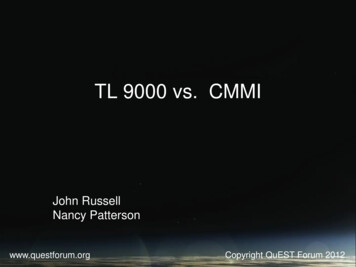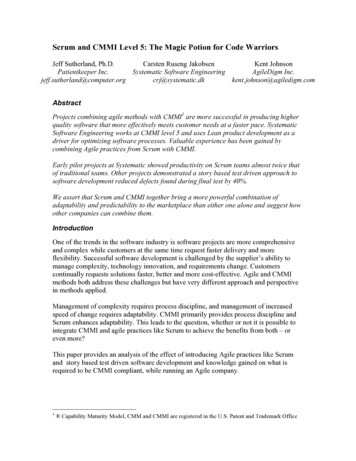
Transcription
CMMI Level 2 for Practitioners:A Focused Course for YourLevel 2 EffortsSoftware Engineering InstituteCarnegie Mellon UniversityPittsburgh, PA 15213Mary Beth ChrissisMay 27, 2009 2009 Carnegie Mellon University
About the presenter: Mary Beth ChrissisMary Beth Chrissis is a senior member of the technicalstaff at the Software Engineering Institute (SEI). Sincejoining the SEI in 1988, Chrissis has coauthored theCapability Maturity Model for Software (SW-CMM) and theCapability Maturity Model Integration (CMMI ) model.Currently, Chrissis is a member of the CMMI v1.3 coredevelopment team, manages the CMMI training team,chairs the CMMI Configuration Control Board (CCB), is amember of the IEEE Software and Systems EngineeringStandards Executive Committee, and is an instructor ofvarious CMMI model-related courses at the SEI.Prior to joining the SEI, Chrissis worked at GTEGovernment Systems in Rockville, MD developing a voiceinformation processing system.CMMI Level 2 for Practitioners WebinarMary Beth Chrissis May 27, 2009 2009 Carnegie Mellon University2
Polling questionDo you work for an organization that has already reached CMMImaturity level 2? YesNoCMMI Level 2 for Practitioners WebinarMary Beth Chrissis May 27, 2009 2009 Carnegie Mellon University3
Today’s topic: CMMI Level 2 for PractitionersA new SEI course that prepares you for the challenges you’ll face onyour maturity level 2 journeyFor more informationwww.sei.cmu.edu/cmmi/level2CMMI Level 2 for Practitioners WebinarMary Beth Chrissis May 27, 2009 2009 Carnegie Mellon University4
AgendaWhy a focused approach?Meeting your level 2 needs: CMMI Level 2 for PractitionersSneak previewNext stepsQuestionsCMMI Level 2 for Practitioners WebinarMary Beth Chrissis May 27, 2009 2009 Carnegie Mellon University5
Why a focused approach?CMMI Level 2 for Practitioners WebinarMary Beth Chrissis May 27, 2009 2009 Carnegie Mellon University6
Why a focused approach?Introduction to CMMI provides an overview of the entire model;students receive a large amount of information quickly.Intermediate Concepts of CMMI provides advanced information forSCAMPI Lead Appraisers and CMMI Instructors.A focused approach serves the needs of the many practitioners whoare working at or toward levels 2 and 3.Because CMMI implementation happens step by step, a focus on thechallenges at specific levels is a natural fit and can providepractitioners with the tools they need to effectively implement CMMI atlevels 2 and 3.CMMI Level 2 for Practitioners WebinarMary Beth Chrissis May 27, 2009 2009 Carnegie Mellon University7
Meeting your level 2 needs:CMMI Level 2 forPractitionersCMMI Level 2 for Practitioners WebinarMary Beth Chrissis May 27, 2009 2009 Carnegie Mellon University8
About CMMI Level 2 for PractitionersCMMI Level 2 for Practitioners can improve your understanding of theCMMI for Development (CMMI-DEV), v1.2 model at Maturity Level 2.This course reviews some fundamental CMMI concepts and focuseson Generic Goal 2 (Institutionalize a Managed Process) and thefollowing process areas: Requirements Management (REQM) Project Planning (PP) Project Monitoring and Control (PMC) Supplier Agreement Management (SAM) Configuration Management (CM) Process and Product Quality Assurance (PPQA) Measurement and Analysis (MA)CMMI Level 2 for Practitioners WebinarMary Beth Chrissis May 27, 2009 2009 Carnegie Mellon University9
Who can benefit from the course?The audience for CMMI Level 2 for Practitioners includes the following: anyone interested in learning more about CMMI SCAMPI team members practitioners and those responsible for improvement efforts who aretrying to understand and implement CMMICMMI Level 2 for Practitioners WebinarMary Beth Chrissis May 27, 2009 2009 Carnegie Mellon University10
What you’ll learn inCMMI Level 2 for PractitionersAt the end of the course, you will have a better understanding of CMMI Maturity Level 2 be able to use CMMI Maturity Level 2 in an appraisal understand how to apply CMMI Level 2 concepts effectivelyDuring the course, students will be able to share, learn, and exchangeideas with other course participants and the instructors.CMMI Level 2 for Practitioners WebinarMary Beth Chrissis May 27, 2009 2009 Carnegie Mellon University11
What to expect in the CMMI Level 2 forPractitioners course2.5 daysInteractive instruction - limited amount of lecture time mixed withquestions that encourage participationSmall-group exercisesReal-world scenariosCMMI Level 2 for Practitioners WebinarMary Beth Chrissis May 27, 2009 2009 Carnegie Mellon University12
Class scheduleCMMI Level 2 for Practitioners WebinarMary Beth Chrissis May 27, 2009 2009 Carnegie Mellon University13
CMMI training: The big pictureCMMI Level 2 for Practitioners WebinarMary Beth Chrissis May 27, 2009 2009 Carnegie Mellon University14
Polling questionsDo you understand how CMMI Level 2 for Practitioners fits withother CMMI training? YesNoDo you understand how CMMI Level 2 for Practitioners canbenefit you? YesNoCMMI Level 2 for Practitioners WebinarMary Beth Chrissis May 27, 2009 2009 Carnegie Mellon University15
Sneak previewCMMI Level 2 for Practitioners WebinarMary Beth Chrissis May 27, 2009 2009 Carnegie Mellon University16
Product Development IModule 4 2009 Carnegie Mellon University
Format for discussing each process area (PA) What does this PA involve? Value Dependencies on other PAs Ordering of specific practices Selected specific practices Selected generic practices PA implementation considerationsCMMI Level 2 for Practitioners WebinarMary Beth Chrissis May 27, 2009 2009 Carnegie Mellon University18
Requirements Management Process AreaThe purpose of Requirements Management (REQM) is tomanage the requirements of the project’s products and productcomponents and to identify inconsistencies between thoserequirements and the project’s plans and work products.CMMI Level 2 for Practitioners WebinarMary Beth Chrissis May 27, 2009 2009 Carnegie Mellon University19
REQM involves Managing the requirements as the product evolves understanding requirements obtaining commitment to requirements recognizing and receiving requirements changes and making decisionsabout how to handle them ensuring customer requirements, project work, and products areconsistent with product requirementsCMMI Level 2 for Practitioners WebinarMary Beth Chrissis May 27, 2009 2009 Carnegie Mellon University20
Value of REQMRequirements management processes prevent inconsistencies between the approved requirements and theproject’s plans and work products assess which requirements, work products, and product components areaffected by a proposed change ensure customer requirements, project work, and products are consistentwith product requirementsCMMI Level 2 for Practitioners WebinarMary Beth Chrissis May 27, 2009 2009 Carnegie Mellon University21
REQM depends on Requirements Development for establishing and maintaining customer, product, product component,and interface requirementsConfiguration Management for controlling changes to requirementsProject Monitoring and Control for taking action to correct identified inconsistencies amongrequirements, project plans, and work productsCMMI Level 2 for Practitioners WebinarMary Beth Chrissis May 27, 2009 2009 Carnegie Mellon University22
PAs that depend on REQMProject Planning for managing requirements needed for planning and replanningSupplier Agreement Management for managing the requirements that will be satisfied by external sources for managing the traceability of requirements for products acquired fromsuppliersRequirements Development for managing customer, product, and product component requirements;obtaining agreement with the requirements provider; obtainingcommitments from the requirements implementers; and maintainingtraceabilityCMMI Level 2 for Practitioners WebinarMary Beth Chrissis May 27, 2009 2009 Carnegie Mellon University23
REQM contextManage RequirementsObtain ionalTraceability etween ProjectWork andRequirementsTraceability MatrixCMMI Level 2 for Practitioners WebinarMary Beth Chrissis May 27, 2009 2009 Carnegie Mellon University24
Polling questionsHow do you feel about the information you’re receiving in thiswebinar? Too technicalNot technical enoughJust RightIs the information you’re receiving relevant to your organizationor job? YesNoDon’t KnowCMMI Level 2 for Practitioners WebinarMary Beth Chrissis May 27, 2009 2009 Carnegie Mellon University25
SP 1.1 Understand RequirementsDevelop an understanding with the requirements providers on themeaning of the requirements.It is important to understand what the project is building. subpractice 1:Establish criteria for distinguishing appropriate requirements providers. subpractice 4:Reach an understanding of the requirements with the requirementsprovider so that the project participants can commit to them.Typical work products lists of criteria for distinguishing appropriate requirements providers criteria for evaluation and acceptance of requirements results of analyses against criteria an agreed-to set of requirementsCMMI Level 2 for Practitioners WebinarMary Beth Chrissis May 27, 2009 2009 Carnegie Mellon University26
SP 1.2 Obtain Commitment to RequirementsObtain commitment to the requirements from the projectparticipants.Project participants must commit to the approved requirements and theresulting changes to their project work. subpractice 1:Assess the impact of requirements on existing commitments.Typical work products requirements impact assessments documented commitments to requirements and requirements changesCMMI Level 2 for Practitioners WebinarMary Beth Chrissis May 27, 2009 2009 Carnegie Mellon University27
SP 1.3 Manage Requirements ChangesManage changes to the requirements as they evolveduring the project.Requirements change! It is important to effectively manage thesechanges. subpractice 1:Document all requirements and requirements changes that are given toor generated by the project. subpractice 3:Evaluate the impact of requirements changes from the standpoint ofrelevant stakeholders.Typical Work Products requirements status requirements database requirements decision databaseCMMI Level 2 for Practitioners WebinarMary Beth Chrissis May 27, 2009 2009 Carnegie Mellon University28
SP 1.4 Maintain Bidirectional Traceability ofRequirementsMaintain bidirectional traceability among the requirements andwork products.It is important to identify which work products are affected by aproposed change. subpractice 2:Maintain requirements traceability from a requirement to its derivedrequirements and allocation to functions, interfaces, objects, people,processes, and work products. subpractice 3:Generate the requirements traceability matrix.Typical work products requirements traceability matrix requirements tracking systemCMMI Level 2 for Practitioners WebinarMary Beth Chrissis May 27, 2009 2009 Carnegie Mellon University29
SP 1.5 Identify Inconsistencies BetweenProject Work and RequirementsIdentify inconsistencies between the project plans and workproducts and the requirements.It is important to know when something is moving “out of synch” withthe currently approved requirements. subpractice 1:Review the project’s plans, activities, and work products for consistencywith the requirements and the changes made to them. subpractice 4:Initiate corrective actions.Typical work products documentation of inconsistencies including sources, conditions, andrationale corrective actionsCMMI Level 2 for Practitioners WebinarMary Beth Chrissis May 27, 2009 2009 Carnegie Mellon University30
REQM Implementation ConsiderationsApplying REQM to existing products and product components imposeslimitations and requires interpretation regarding the following: how to document pre-existing requirements the amount of traceability needed how you address the requirementsThe identification of relevant stakeholders may be limited by the type oforganization and contract.Does the size or duration of the project have an impact on the way youwould implement Requirements Management?Are there changes that cannot be accepted?CMMI Level 2 for Practitioners WebinarMary Beth Chrissis May 27, 2009 2009 Carnegie Mellon University31
Next stepsCMMI Level 2 for Practitioners WebinarMary Beth Chrissis May 27, 2009 2009 Carnegie Mellon University32
What’s coming up?CMMI Level 2 for PractitionersSEI public courses available June 2009Licensing available December 2009CMMI Level 3 for PractitionersPartner Pilots July 2009 – September 2009SEI public courses available August 2009Licensing available December 2009CMMI Level 2 for Practitioners WebinarMary Beth Chrissis May 27, 2009 2009 Carnegie Mellon University33
SEI public courses:CMMI Level 2 for PractitionersJune 23-25, 2009 (SEI Pittsburgh, PA)July 27-29, 2009 (SEI Frankfurt, Germany)September 28-30, 2009 (SEI Arlington, VA)CMMI Level 2 for Practitioners WebinarMary Beth Chrissis May 27, 2009 2009 Carnegie Mellon University34
More e 412-268-5800Webwww.sei.cmu.edu/cmmi/level2CMMI Level 2 for Practitioners WebinarMary Beth Chrissis May 27, 2009 2009 Carnegie Mellon University35
QuestionsCMMI Level 2 for Practitioners WebinarMary Beth Chrissis May 27, 2009 2009 Carnegie Mellon University36
CMMI Level 2 for Practitioners WebinarMary Beth Chrissis May 27, 2009 2009 Carnegie Mellon University37
CMMI Level 2 for Practitioners can improve your understanding of the CMMI for Development (CMMI-DEV), v1.2 model at Maturity Level 2. This course reviews some fundamental CMMI concepts and focuses on Generic Goal 2 (Institutionalize a Managed Process) and the following process areas: Requirements Management (REQM) Project Planning (PP)










